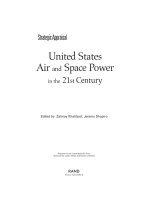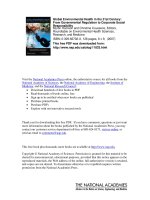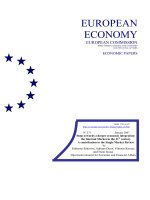Transitional china in the 21st century
Bạn đang xem bản rút gọn của tài liệu. Xem và tải ngay bản đầy đủ của tài liệu tại đây (13.79 MB, 194 trang )
HE JINLIAO, HE KE AND WEI LINLIN
TRANSITIONAL CHINA IN
THE 21ST CENTURY
A GUIDE BOOK FOR
UNDERSTANDING
EMERGING CHINA
Download free eBooks at bookboon.com
2
Transitional China in the 21st Century: A Guide Book for Understanding Emerging China
1st edition
© 2017 He Jinliao, He Ke and Wei Linlin & bookboon.com
ISBN 978-87-403-1726-8
Peer review by Prof. Dr. Hans Gebhardt, Head of the Department Geographical Institute
University of Heidelberg
Download free eBooks at bookboon.com
3
CONTENTS
TRANSITIONAL CHINA IN THE 21ST CENTURY
CONTENTS
Preface
6
Acknowledgements
7
1
Introduction
8
2
China’s New Economy and Industrial Transformation in the
21st Century
13
2.1
Development of China’s ICT Industry
15
2.2
Chinese Smart Phone Industry
29
2.3
High-speed Railway
46
www.sylvania.com
We do not reinvent
the wheel we reinvent
light.
Fascinating lighting offers an ininite spectrum of
possibilities: Innovative technologies and new
markets provide both opportunities and challenges.
An environment in which your expertise is in high
demand. Enjoy the supportive working atmosphere
within our global group and beneit from international
career paths. Implement sustainable ideas in close
cooperation with other specialists and contribute to
inluencing our future. Come and join us in reinventing
light every day.
Light is OSRAM
Download free eBooks at bookboon.com
4
Click on the ad to read more
CONTENTS
TRANSITIONAL CHINA IN THE 21ST CENTURY
3
Urban Development of China in the 21st Century
62
3.1
Land Policies and Demolition Issues in China
62
3.2
Population and Social Transformation of China
73
3.3
Population Flow in China
83
3.4
Urban problems
93
4
Globalization – Rising China in the 21st Century
122
4.1
Changing Role in the Global Economy
124
4.2
China’s foreign policy under the “new normal”
142
4.3
Cultural identity in the context of globalization
160
References
182
About the authors
191
Endnotes
194
Download free eBooks at bookboon.com
5
PREFACE
TRANSITIONAL CHINA IN THE 21ST CENTURY
PREFACE
Over the past decades, China has been in dramatic transition in economic, social and urban
spheres. hese transformations are comprised of industrial reconstruction (e.g., the rapid
rise of high-tech and creative industries), a new landscape of growing cities in China, as
well as globalizing economy and culture. In order to update the knowledge of a changing
China, this book focuses on some new developments in industrialization, urbanization and
globalization since the beginning of 21st century. It aims to provide overseas readers with
an introduction to some topical issues in recent China studies, and further lead to a better
understanding of transitional China and its relationship with the outside world, especially
Western society.
hree basic aspects of China studies will be addressed in this book, namely, industrialization,
urbanization and globalization. First, it will briely trace the development path of China’s
new economy since the 1990s. More importantly, it questions what happed in recent
years. What can other parts of the world learn from China’ economic and urban practices?
Considering especially topical issues such as “made in China 2025”, network+ economy
in China, the new global strategy by the Xi-Li regime (President Xi Jinping and Primer
Minister Li Keqiang), and so forth – what are challenges and opportunities existing in these
processes? he book will introduce as well the spatial transition of China’s economy and
population over the past years (e.g., demographic immigration). Second, great attention will
be placed on urbanization of today’s China, including a glance at land-use systems, urban
social transformation, population structure and mobility, and urban problems. Lastly, the
book will introduce the new role of China in the process of globalization, and the new
strategies for China going outside and participating in establishing a new order in the world
in the new century.
hough this book is not a theoretical textbook, the explanations are based on a wide range
of theories from urban, economic, cultural, and political studies. Most of the chapters are
based on the research results of the authors and their colleagues. he book will adopt a
large amount of data, including statistic data, graph, and maps. All in all, this book will
provide students with a colorful story about present China studies.
Download free eBooks at bookboon.com
6
ACKNOWLEDGEMENTS
TRANSITIONAL CHINA IN THE 21ST CENTURY
ACKNOWLEDGEMENTS
he book is a cooperative work by me and other two co-authors from Germany and hailand,
to whom I am grateful. Special thanks go to my student assistants Gu Wei, He Qiong, and
Li Peize at Nanjing University, who have been dealing with a large number of materials
and data processing. I also appreciate the comments and suggestions from my former PhD
supervisor Prof. Hans Gebhardt, Geographical Institute, Heidelberg University. Finally, I
want to express my gratitude to the publishing house Bookboon. It would not have been
possible to publish the book without the support from the team in Bookboon.
Dr. Jinliao He
Nanjing
September 2016
Download free eBooks at bookboon.com
7
INTRODUCTION
TRANSITIONAL CHINA IN THE 21ST CENTURY
1
INTRODUCTION
Chapter contents:
• Industrialization
• Urbanization
• Globalization
In recent political and academic discussion, great attention has been drawn to China, a
country that has been emerging dramatically over the past three decades in both economic
and political domains. Nevertheless, for the rest of the world, China is a place remaining
relatively under-explored, its people, governance, culture, and intellectual thinking full of
mystery. his asymmetric knowledge to China of the outside world causes misunderstanding
and even unnecessary anxiety about a rising China, expressed through well-known declarations
such as ‘the China threat’ (Gertz, 2013). For other people with limited interest in China,
their knowledge and perception of China is perhaps from national media and fragmentary
information which exaggerates one side of the facts while understates the others, leading to
a biased vision of this eastern state with a long history and a huge population. It is timely to
present the reality of today’s China for the rest of the world, in a sense of a general overview
of the new developments, problems, lessons, and opportunities (Storey and Yee, 2004).
In order to provide a holistic understanding about emerging China, and more recently
transitional China, three basic dimensions – industrialization, urbanization and globalization – are
necessarily introduced before a general idea can be formed. Above all, China’s growth starts
with a hysterical revolution, known as industrialization, that happened one hundred years
ago in West. China was a typical agricultural nation before reform and opening-up. But
it shifted sharply when external and endogenous capitalists were allowed to operate their
factories and enterprises, initially in some special areas such as Shenzhen, the irst place
opened, and then everywhere in China. New technologies, ventures, management, inancial
bodies, and more importantly, the cheap labor, GDP-based regime and policies, and perhaps
the vertically structured one-party system, all lead to earthshaking changes. his transition
was further promoted when China inally entered into the WTO (World Trade Organization)
in 2001. Since then a label of ‘made in China’ can be seen everywhere in the world. his
delayed industrialization brought Chinese people great wealth (unfortunately for only a
small proportion of the people) and a huge amount of currency for the Chinese government
in terms of tax revenues and state-owned properties, supported by the fact that Chinese
governments own the greatest amount of property in the world, valued ca. $85,953 billion
according to the Chinese Social Science Academy (Li et al., 2015).
Download free eBooks at bookboon.com
8
INTRODUCTION
TRANSITIONAL CHINA IN THE 21ST CENTURY
However, in the recent years this rapid change or development is seemingly unsustainable in
light of huge social disparities, decreasing population of young laborers but increasing labor
cost and housing prices, as well as deteriorating environmental efects created in the process
of the former growth-pursuant mode of industrialization, which has made China gradually
lose its competitiveness in the global system. A new issue termed ‘transitional China’ is
therefore proposed by Chinese scholars in order to redress current development paths highly
dependent on labor and raw materials towards a new economy relying on innovation and
technology. China has established its status as the biggest state of manufacturing production
and now faces its decline, and comes into a new era of knowledge-based economy. Will
China be successful in the new economy as it was in the previous industrialization which
is actually a spatial shift from post-industrial countries to the developing socieites? In the
world of knowledge-based economy, is western super power, especially the USA, going to
welcome a new competitor like China? It might be too early to make any conclusion at this
moment, when China is still in a process of transformation; but impressive performance
has already been achieved in some high-tech industrial ields, such as ICT (Information
and Communications Technology), smart phone production, and high-speed railways, in
which China is no longer a follower but an innovator and perhaps leader.
Industrialization doesn’t go alone but walks side by side with another overwhelming social
and population transformation termed urbanization. China was not an urbanized society
until after the 1990s when industrialization developed to a point that a huge amount of
assembly line workers was demanded in the industrial areas, particularly in southern China
in places like like Guangzhou-Shenzhen-Dongguan. In these cities, migrant workers (in
Chinese nongmingong) from rural regions of China, mainly from inland provinces such as
Sichuan, Hunan, Hubei, were able to ind factory jobs with a payment higher than what
they could get in their hometowns as famers or craftsmen. hese young laborers were usually
not highly educated but skilled enough for mass production work in factories characterized
as Fordism. Some of them were even fortunate enough to make themselves rich and become
entrepreneurs inally in a world full of venture capital opportunities. However, most of them
are not ‘qualiied’ as urban residents according to Chinese hukou policy (China’s household or
residence registration system), a particular regulation to control the mobility of populations
in China. Without an oicial hukou in the cities, citizens ind themselves having too many
diiculties getting their kids educated, getting social welfare for medical care, unemployment
insurance, retirement pay, and even being prohibited from buying a house (in some irsttier cities like Beijing and Shanghai). his makes migrant workers a special group of people
who need to travel between home and workplace similar to migratory birds; they come back
home each spring festival to visit their families (kids, parents and relatives), and go back
again to the city for their jobs after a short break for the new year holiday. And that causes
intensive transport phenomena during the spring festivals (in Chinese chunyun), leading
to a huge number of travelers in a duration of about one month or so, as many as almost
double the Chinese population of 1.3 billion.
Download free eBooks at bookboon.com
9
INTRODUCTION
TRANSITIONAL CHINA IN THE 21ST CENTURY
However, this process of industrial migration is seemingly irreversible, since all of these
young workers have lost their skills and motivation to go back to do farm work in the
countryside. hey tend to search for new urban life for their future, which thus stimulates
a great demand for urban facilities and houses in the cities. Urbanization is boosted in the
industrializing China. When more and more people gather in the cities, urban expansion
speeds out of control. Meanwhile, Chinese governments ind that there is endless wealth
through selling land to real estate developers, enterprises, and foreign investors. Finally,
the industrializing China has now become an urbanizing China; iscal revenues based on
exports have been replaced by land inances relying on housing markets (Cao et al., 2008).
According to Chinese laws of land ownership, all of the land belongs to the state, who has
right to acquire any land in the name of public beneits, as it has been doing everywhere
in China today, so-called Chaiqian (demolition). Local governments, usually in a form of
state-owned companies, take over the land from residents with very little compensation but
sell at high value in the land market. Intense social conlicts are therefore created between
these displaced citizens and local governments or these developers. But it is not necessarily
the same story for all the demolition cases. In some big cities like Shanghai, Beijing, and
Shenzhen, for example, demolition is always good news for local residents who can get high
compensation from the governments, such as a new apartment worth of millions of Yuan.
But at the same time they lost their farmlands forever, and became jobless, which gives rise
to potential social risks for the future.
Urban problems are not unique issues in China, but are repeated in more stories and
features in fast-growing China. One problem that can be considered a symbol for China’s
industrialization and urbanization is air pollution over the past decade, known as smog
and haze, especially in the northern areas, such as Beijing and Shenyang, where more
than two thirds of the winter days go on with no sunlight, not to mention blue sky. his
unconcealed fact reminds Chinese people and in particular the government with a warning
that the way of industrialization and urbanization like before can actually not be sustained
anymore. Consequences of rapid industrialization and urbanization include even more serious
problems such as water pollution, soil pollution, food security, and traic congestion; and
those problems cannot be easily observed while scientiic monitoring information is not
open for the public yet. All of these present big challenges for the “transitional China” in
the new century.
Download free eBooks at bookboon.com
10
INTRODUCTION
TRANSITIONAL CHINA IN THE 21ST CENTURY
Since the beginning of 21st century, China has been quickening its pace ‘going abroad’,
starting with entering the WTO by exporting a massive amount of products made in China,
and continuing with rising entrepreneurs and capitalists who have purchased assets globally
in recent years. But, China’s emergence is not conined to the ield of economy, extending
rather as far as the former system of global politics and governance, as well as cultural and
educational dimensions. China is making claims for more shareholding in international issues
by proposing and providing new game-changing rules such as the leadership of Shanghai
Cooperation Organization (SCO), the establishment of Asian Infrastructure Investment Bank
(AIIB), the new transnational program of ‘One Belt, One Road’, which inevitably challenge
the West’s power, especially the USA. As has been widely noticed by recent media, more
political geographic spaces are frequently declaimed for the areas surrounding China. For
instance, the South China Sea, which has been under the supervision of the US army since
the end of the Second World War, is now declaimed under China’s sovereign rights with an
understandable reason of geographic proximity and historical precedent. Cross-state tension
is therefore created among diferent political powers, including a group of southeast Asian
states like the Philippines, Vietnam, Indonesia, and the political alliance of Japan and the
USA. However, it isn’t necessary to see this as the omen of war. First of all, the world is
now a complex place with great interdependence. hese countries with potential conlicts
with China are in fact important economic partners with one another. he relationship
between China and USA is rather interwoven, which requires a more tolerant and lexible
collaborative framework. Moreover, China’s emergence in the recent half-century has rarely
occurred with invasion and expansion as an armed empire. It might be associated with the
Chinese tradition of Confucianism, which highly emphasizes harmony and multi-beneicial
relationships instead of hegemony.
he following chapters will present more speciic introductions and discussions related to the
issues of industrialization, urbanization, and globalization in current day China. In chapter 2,
an overview of some new developments in Chinese industries will be introduced, including
ICT, smartphone, and high-speed railway production. It aims to provide international
readers with updated knowledge about a transitional China which is no longer a low-end
manufacturing region but a vital center for high-technology and innovation. Chapter 3 will
address a broad range of topics with regard to urbanization in recent China. It helps outside
readers understand some unique Chinese facts such as a state-owned land system, hukou
policy, migrant workers, as well as an increasing number of urban problems in China. In
the last chapter of this book, the authors provide a new picture of a globalizing China who
is on the way to reconstructing world order strongly and peacefully.
Download free eBooks at bookboon.com
11
INTRODUCTION
TRANSITIONAL CHINA IN THE 21ST CENTURY
References
Cao, G. Feng, C. and Tao, R. (2008), Local “land inance” in China’s urban expansion:
challenges and solutions. China & World Economy, 16(2): 19–30.
Gertz B. (2013), he China hreat: How the People’s Republic Targets America. Regnery
Publishing.
Li, Y., Zhang, X.J. and Chang X. et al., (2015), China national Balance Sheet 2015, China
Science Press, 2015, Beijing.
Storey, I. and Herbert Y., (2004), he China threat: perceptions, myths and reality. Routledge.
360°
thinking
.
Discover the truth at www.deloitte.ca/careers
Download free eBooks at bookboon.com
12
© Deloitte & Touche LLP and affiliated entities.
Click on the ad to read more
CHINA’S NEW ECONOMY AND INDUSTRIAL
TRANSFORMATION IN THE 21ST CENTURY
TRANSITIONAL CHINA IN THE 21ST CENTURY
2
CHINA’S NEW ECONOMY AND
INDUSTRIAL TRANSFORMATION
IN THE 21ST CENTURY
Chapter contents:
• Development of China’s ICT Industry
• Chinese Smart Phone Industry
• High-speed Railway
Since the start of the new century, China’s manufacturing industries based on low technology
have encountered a big challenge in the increasing costs of labors and raw materials, as well
as a deteriorating environment. Chinese economic players thus present great enthusiasm for
learning western technologies and new business modes. A “catching-up movement” can been
seen everywhere, from the central government to private enterprises. What surprised the
world in recent years is that China’s absorptive capacity for learning new technologies makes
them actually overtake some of their western “teachers”. A well-known case is high-speed
railway technology, which was initially introduced from global leaders including Siemens,
the Bullet Train (Japan), etc. But now China has made a miraculous achievement, leading
in producing high quality but low-cost high-speed railway lines and trains. Similar events
occurred in some other industrial ields like ICT and smartphone production. A private
company Huawei has become the biggest telecommunication producer in the world since
2013. Meanwhile, China has remained the biggest exporter in world trade of ICT products
since 2003, sharing 35% of the world market in 2013. Chinese cell phone producers are
increasing rapidly in recent years. New smartphone enterprises like Huawei, Xiaomi and
Lenovo have been rising and are ready to challenge the global leaders Apple and Samsung.
Download free eBooks at bookboon.com
13
CHINA’S NEW ECONOMY AND INDUSTRIAL
TRANSFORMATION IN THE 21ST CENTURY
TRANSITIONAL CHINA IN THE 21ST CENTURY
A conversional point of view regards China as the world factory for mass production, which
is stereotyped as “made in China” or by a more recent label “assembled in China”. It is true
that China still holds the biggest group of labor-intensive factories and producing lines,
while it is a less known fact that China is rising as a competitive supplier for cultural and
creative products, remaining in the leading position of world exports of creative goods since
2005 (UNCTAD 2010). hat of course doesn’t take into account China having the largest
population. hough it is debatable regarding some creative products which might be not
“creative” at all according to a western understanding of creativity, it is not debatable that
China is a state with abundant assets of culture and historical heritages. In fact, within the
new political framework of the Chinese Communist Party, the former regime by President
Hu Jintao-Wen Jiabao and the current new regime by Xi Jinping-Li Keqiang, cultural strategy
is considered as an essential competitive edge factor, known as soft power. Especially, in the
current Xi-Li new political plan, state-power is somewhat ready to hang back from strict
control over cultural sectors and business ields. Market leverage is expected to play a more
important role in cultural production.
A wave of a new currency has been washing over China in more recent years, termed here as
network economy, or network+ (plus). Never before has China made such a market success
and enjoyed the depth of technological revolution that China is now experiencing in the
ields of internet and e-business. Network+ is substantially changing China in every aspect
of daily life, from consuming behaviors, production, and distribution models, to political
governance, or even the inancial system, much more profoundly than in other countries.
Especially for new Chinese generations who are used to and accept new technologies, they
tend to be obsessed with online-shopping and calling for taxis, food searches via smartphone,
etc. A private e-business Alibaba presents an example of how a small enterprise in China was
able to grow up to be one of the biggest in the world among their kind within 15 years.
According to its market value in the New York Stock Market, Alibaba has now surpassed
the global leaders Amazon and EBay. he impacts that Alibaba brings to China are as
huge as Facebook’s for the western world. Alibaba is actually not limited to retail business,
extending as far as inancial and banking systems, and a new plan to expand into medical
and health markets as well. As we can see, in many cases, Chinese people don’t use cash
but transfer through Alipay – a tool that is equivalent to PayPal, but more convenient since
it is bounded with the personal cell phone. Nowadays, the followers of Ma Yun (CEO of
Alibaba), mainly young entrepreneurs, seek to apply network technologies to most of the
traditional quarters of economy. It sometimes challenges the traditional sectors and brings
new ways of businesses, for instance, the recent controversy on APP calling for taxis (DIDI
or Uber) vs traditional model of taxi service.
Download free eBooks at bookboon.com
14









